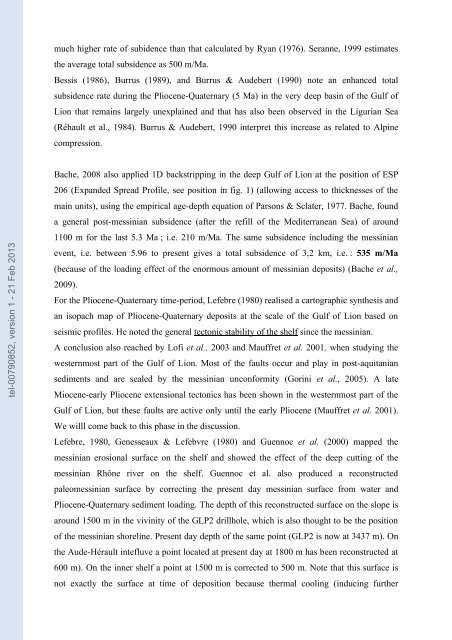Quantification des flux sédimentaires et de la subsidence du bassin ...
Quantification des flux sédimentaires et de la subsidence du bassin ...
Quantification des flux sédimentaires et de la subsidence du bassin ...
Create successful ePaper yourself
Turn your PDF publications into a flip-book with our unique Google optimized e-Paper software.
tel-00790852, version 1 - 21 Feb 2013<br />
much higher rate of subi<strong>de</strong>nce than that calcu<strong>la</strong>ted by Ryan (1976). Seranne, 1999 estimates<br />
the average total subsi<strong>de</strong>nce as 500 m/Ma.<br />
Bessis (1986), Burrus (1989), and Burrus & Au<strong>de</strong>bert (1990) note an enhanced total<br />
subsi<strong>de</strong>nce rate <strong>du</strong>ring the Pliocene-Quaternary (5 Ma) in the very <strong>de</strong>ep basin of the Gulf of<br />
Lion that remains <strong>la</strong>rgely unexp<strong>la</strong>ined and that has also been observed in the Ligurian Sea<br />
(Réhault <strong>et</strong> al., 1984). Burrus & Au<strong>de</strong>bert, 1990 interpr<strong>et</strong> this increase as re<strong>la</strong>ted to Alpine<br />
compression.<br />
Bache, 2008 also applied 1D backstripping in the <strong>de</strong>ep Gulf of Lion at the position of ESP<br />
206 (Expan<strong>de</strong>d Spread Profile, see position in fig. 1) (allowing access to thicknesses of the<br />
main units), using the empirical age-<strong>de</strong>pth equation of Parsons & Sc<strong>la</strong>ter, 1977. Bache, found<br />
a general post-messinian subsi<strong>de</strong>nce (after the refill of the Mediterranean Sea) of around<br />
1100 m for the <strong>la</strong>st 5.3 Ma ; i.e. 210 m/Ma. The same subsi<strong>de</strong>nce including the messinian<br />
event, i.e. b<strong>et</strong>ween 5.96 to present gives a total subsi<strong>de</strong>nce of 3,2 km, i.e. : 535 m/Ma<br />
(because of the loading effect of the enormous amount of messinian <strong>de</strong>posits) (Bache <strong>et</strong> al.,<br />
2009).<br />
For the Pliocene-Quaternary time-period, Lefebre (1980) realised a cartographic synthesis and<br />
an isopach map of Pliocene-Quaternary <strong>de</strong>posits at the scale of the Gulf of Lion based on<br />
seismic profiles. He noted the general tectonic stability of the shelf since the messinian.<br />
A conclusion also reached by Lofi <strong>et</strong> al., 2003 and Mauffr<strong>et</strong> <strong>et</strong> al. 2001, when studying the<br />
westernmost part of the Gulf of Lion. Most of the faults occur and p<strong>la</strong>y in post-aquitanian<br />
sediments and are sealed by the messinian unconformity (Gorini <strong>et</strong> al., 2005). A <strong>la</strong>te<br />
Miocene-early Pliocene extensional tectonics has been shown in the westernmost part of the<br />
Gulf of Lion, but these faults are active only until the early Pliocene (Mauffr<strong>et</strong> <strong>et</strong> al. 2001).<br />
We willl come back to this phase in the discussion.<br />
Lefebre, 1980, Genesseaux & Lefebvre (1980) and Guennoc <strong>et</strong> al. (2000) mapped the<br />
messinian erosional surface on the shelf and showed the effect of the <strong>de</strong>ep cutting of the<br />
messinian Rhône river on the shelf. Guennoc <strong>et</strong> al. also pro<strong>du</strong>ced a reconstructed<br />
paleomessinian surface by correcting the present day messinian surface from water and<br />
Pliocene-Quaternary sediment loading. The <strong>de</strong>pth of this reconstructed surface on the slope is<br />
around 1500 m in the vivinity of the GLP2 drillhole, which is also thought to be the position<br />
of the messinian shoreline. Present day <strong>de</strong>pth of the same point (GLP2 is now at 3437 m). On<br />
the Au<strong>de</strong>-Hérault intefluve a point located at present day at 1800 m has been reconstructed at<br />
600 m). On the inner shelf a point at 1500 m is corrected to 500 m. Note that this surface is<br />
not exactly the surface at time of <strong>de</strong>position because thermal cooling (in<strong>du</strong>cing further

















